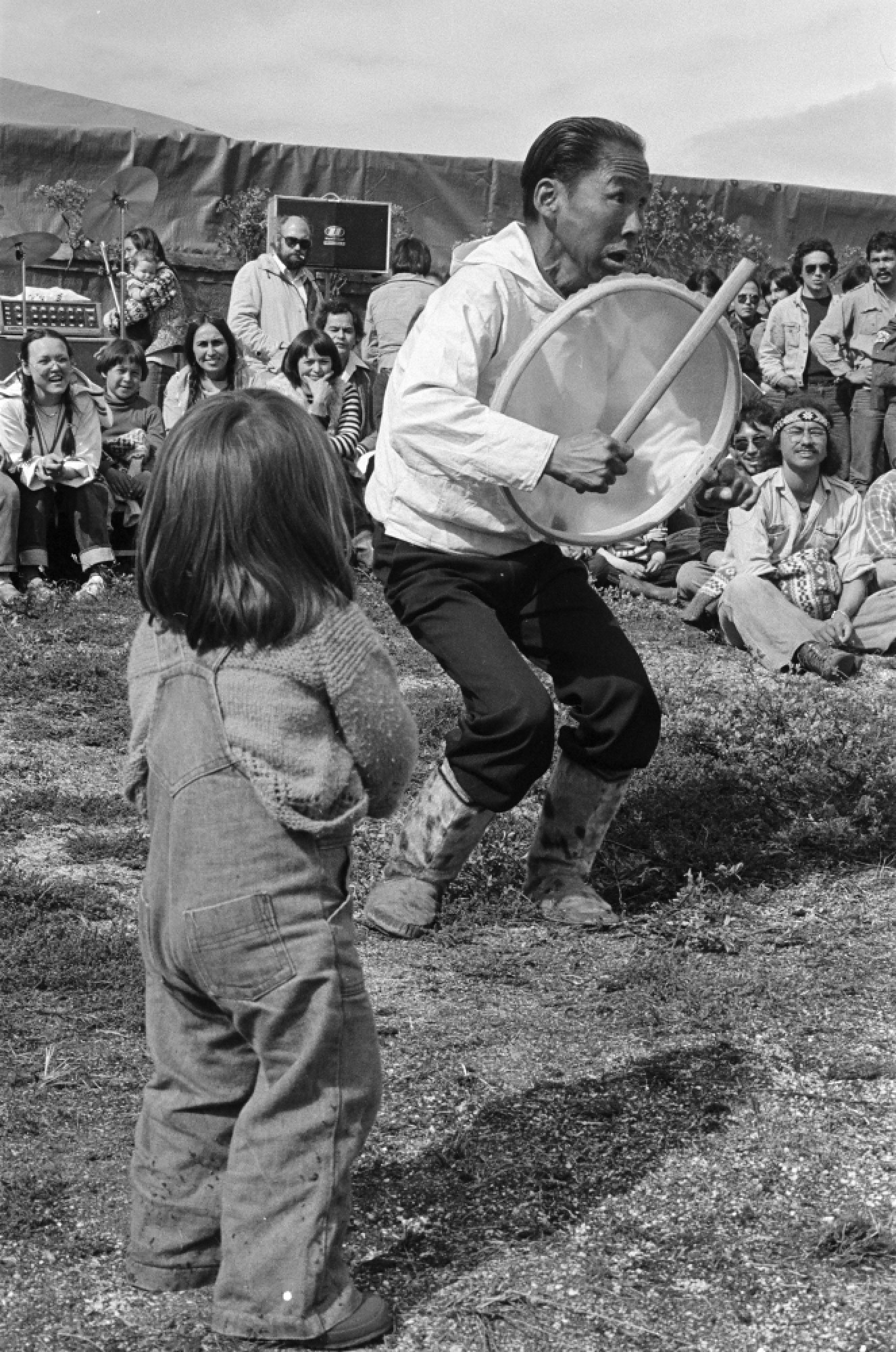
ANNE BANG/ARKTISK INSTITUT, 1980
Drum dance and drum song have traditionally had social, religious and cultural significance; they have been used as entertainment, storytelling, flirting, as part of spiritual ceremonies and to settle disputes. The songs have been passed down from generation to generation, and the performance of drum song and dance can be a mix of music, dance and acting. They can be performed by both men and women.
The historical background
The first Greenlandic frame drums (qilaat) and fragments of such drums date back more than 4,000 years and have been found in men’s houses in Northwest Greenland. It is therefore assumed that the tradition came to Greenland with the Inuit.
The Inuit frame drum comes in many varieties, from the relatively large East Greenland drum to the small and slender North Greenland drum. The construction also varies from region to region, but basically the drum is made of wood or bone, over which is stretched a membrane of animal skin or hide, which resonates when the underside of the frame is struck with a wooden or bone drumstick. During the performance, the person will traditionally stand with his or her legs slightly apart and make a series of body movements while singing and drumming. The drum was an important part of the Angakkoq’s spirit ceremony or spirit journeys.
When the Danish-Norwegian mission arrived in West Greenland in 1721, drum song and dance were associated with pagan culture and was more or less outright prohibited. Therefore, the main knowledge of the tradition comes from East and North Greenland.
Drum duel

ANNE BANG/ARKTISK INSTITUT, 1980
Drum dance and drum song have been used in the East Greenlandic drum duel. Here, disputing parties could sing accusations and perform light violence against each other in front of a choir made up of the disputing parties’ families. In this way, the parties were able to resolve conflicts as an alternative to violence and vendetta.
The drum duel was the Inuit court system where disputes were settled by the verdict of the audience after the disputing parties had sung and danced their songs against each other. If a person became so angry at the audience’s laughter that he was unable to complete the duel, he would automatically lose.
The drum duels were usually performed at the large aasiviit, the large summer camps at Sermermiut, Taseralik, Kangeq, Uunartoq and Aluk, to which the Inuit travelled long distances to meet, trade and find potential new partners.
Renewed interest in the tradition
In the wake of the Greenlandisation from the 1970s and onwards, there has been a growing interest in drum song and dance as an indigenous Greenlandic musical culture. The tradition has undergone a revival, consisting partly of traditional performance of collected drum songs, partly of new compositions and integration of drum song and dance into globalised music genres.
Danish ethnomusicologist Michael Hauser recorded drum songs in the Thule region in the 1980s, where the tradition was disappearing. He wrote down and analysed the songs and was able to demonstrate that many of the songs have a complex structure, while others are simpler. The latter originates from later immigration from the West, the last in the 1860s.
Robert Hivshu Peary, who grew up in Thule and is trained in traditional drum dance, has been working to revive the tradition. In 2010, Michael Hauser published Traditional Inuit Songs from Thule Area, a work of over 1,500 pages, made in collaboration with Robert Hivshu Peary, among others. In 1975, ethnomusicologist and composer Poul Rovsing Olsen released songs by Egon Sikivat, a wellknown drum singer from Kuummiut in East Greenland.
In 2021, drum dance and song (qilaatersorneq) was entered on UNESCO’s list of Intangible Cultural Heritage. One of the aims is to ensure a living cultural heritage. Greenland is the first country in the Unity of the Realm to have a cultural expression accepted on this list. The inclusion on the list is not only about Greenlandic drum dance and song but also about the use of the frame drum by other indigenous peoples in the Arctic.
Further reading
- Association activities and volunteering
- Hans Egede and the work for the mission service
- Inuit way of life
- Kalattuut – Greenlandic style
- Music
- Paleo-Inuit
- The Inuit culture, precolonial period
- Theatre and dance
- Traditions and tales
Read more about Culture in Greenland
